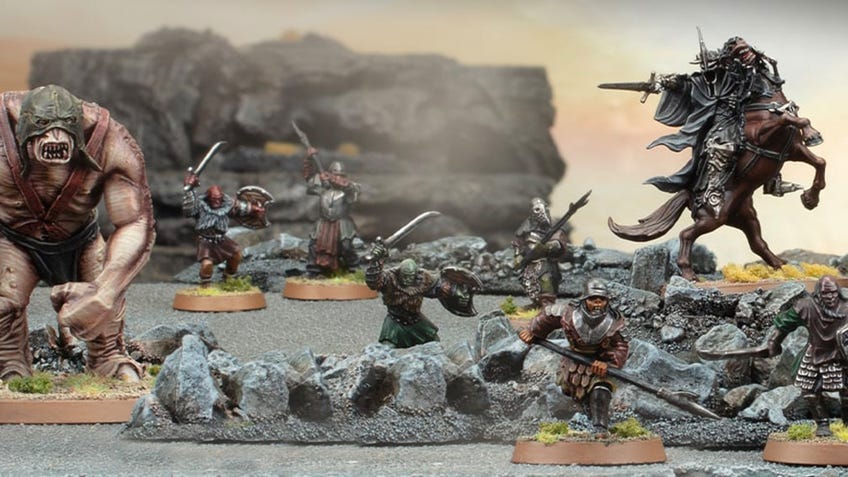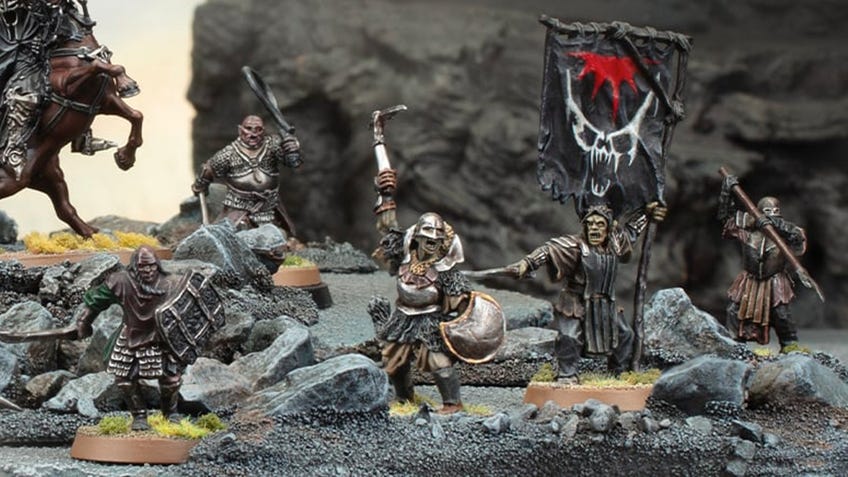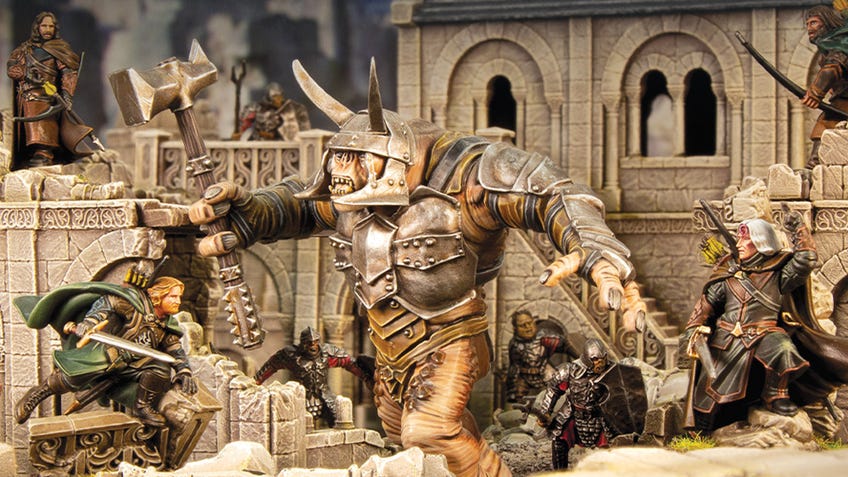Lord of the Rings, meet Warhammer: Why the Middle-Earth Strategy Battle Game may secretly be Games Workshop’s best game
One to Ring in the New Year with.
The question of which of Games Workshop’s many tabletop miniatures games is the best is certainly a contentious one. The most popular is undoubtedly Warhammer 40,000. However, I’d argue that, in its current state, it’s possibly GW’s worst offering, thanks to convoluted bespoke special rules for the various factions and units; this overcomplexity results in huge amounts of mental overhead during a game and has proven to be a balancing nightmare in the competitive scene. Perhaps ironically, the game I’d hold up as GW’s best right now isn’t a Warhammer game at all, but the clumsily-titled Middle-Earth Strategy Battle Game. Or MESBG, if you want an unpronounceable acronym.
If I asked you to picture what a Lord of the Rings miniatures game based specifically on the Peter Jackson movies would look like, MESBG is almost exactly what you’d expect. Two armies - ideally one Good, one Evil - fight it out to achieve a variety of objectives over a number of turns. Compared to the big, overblown maximalism of GW’s own settings, MESBG is a restrained, unassuming thing. Even the minis are smaller, being roughly 25 to 28mm scale, as opposed to Warhammer’s usual 30 to 32mm. They’re supposed to resemble the characters from the movies (which they do with varying levels of success), not genetically-enhanced superhuman space warriors.
As the only licensed game produced by GW, it’s quite easy to overlook MESBG. It certainly doesn’t have the same presence as its Warhammer titles, and has evolved a community that has a lot less overlap with the wider GW player base than you might expect. A combination of Tolkien’s world being a big draw in and of itself and a lot of players being introduced to the game by the Battle Games in Middle-Earth magazine, which included miniatures and ran from 2002 to 2006, has resulted in MESBG having its own ecosystem with an active tournament scene that may surprise a lot of Warhammer players.

One of MESBG’s standout features is how well it scales. Right from the original version of the game, then known as The Lord of the Rings: The Fellowship of the Ring - A Strategy Battle Game, it was designed to make the Fellowship’s desperate escape from goblins in Moria just as compelling as the Last Alliance clashing with the armies of Sauron. As it went through various iterations, it added pretty much every character from all six Lord of the Rings and The Hobbit movies, plus a whole bunch that were either taken from the books (good news for Tom Bombadil fans), or added by GW to flesh out the factions that were a little light on named heroes.
A couple of decades of refinement have resulted in a game that is just as good for balanced, competitive play as it is for replicating scenes from the movies.
This last point is especially important, as heroes are at the core of what makes the game so scalable - and so darn good. Heroes are your named characters - the likes of Frodo, Aragorn and Gandalf - as well as generic leader types called things like “Orc Captain”. When playing the points-based, Matched Play rules, your army is organised into a number of warbands consisting of a hero and the regular warriors they lead. As well as having the better stats and special abilities that you’d expect, heroes gain pools of points called Might, Will and Fate, which they can use to activate special Heroic Actions, cast spells and even defy death. It opens a huge range of tactical possibilities when your army only consists of a few heroes, without bogging things down as their warbands increase in size.
A couple of decades of refinement have resulted in a game that is just as good for balanced, competitive play as it is for replicating scenes from the movies or delving into your own takes on the world of Middle-Earth. MESBG is a game where your army can be anything from the disposable hordes of Goblin-Town to Smaug. Yeah, just Smaug. The Greatest Calamity of Our Age can be fielded as his own force and weighs in at 700 points. When you consider that a typical Matched Play game has a limit of 800 points, you can see what a heavy hitter he is.

While I say a typical game is 800 points, that’s only one of the game sizes the community has broadly settled on, the midpoint of the 600 to 1000 range suggested by the rules for a regular battle. MESBG still works very well with 300 to 400 point skirmishes or massive 1250-plus engagements. It’s helped keep the tournament scene interesting, as a particular faction or build that excels at 800 points may be a lot less of a threat at 600, so instead of a single meta, army rankings vary depending on the points limit.
The melee combat rules may sound a little odd, but they have a lot of depth and help balance different armies.
The game’s core rules are straightforward and elegant. The bulk of each turn is split into typical movement, shooting and melee combat phases. Turn order sits at an interesting halfway point between “I go, you go” and alternating activations. Each turn, priority is established with a simple roll-off and the player with priority completes all of their actions each phase, followed by their opponent. The exception to this is the melee phase, as combat in MESBG is simultaneous, but the player with priority gets to decide which order fights are resolved in.
Melee combat is, of course, the main event and is quite unusual in how it plays out. Combatants are divided into individual duels, sometimes one on one, often with one fighter being outnumbered by their enemies. You roll a d6 (which, as is the case with most GW games, are used throughout) for each attack you have, whether that’s from a single model with multiple attacks or multiple models in the fight. Whoever rolls highest wins the combat, with the Fight value of the model only coming into play to decide ties. The loser is knocked back and it’s only then that a roll to see if any damage is caused is made.
It may sound a little odd, but it has a lot of depth and helps balance different armies. Elves, for example, have some of the highest Fight values in the game, so they tend to win in fair fights, but they’re not particularly strong and can have trouble actually killing their opponents. An individual goblin won’t fare well against an elf, but they’ll tend to outnumber them significantly, greatly increasing the chance of winning the attack roll.
Different equipment loadouts can also make a huge difference. A lot of the armies in MESBG only have a couple of different warrior types. To continue with elves as our example, Rivendell has about a dozen different heroes, but only two warriors, which can be summarised as “elf” and “elf on horse”. To mix things up, you can equip them with bows, or shields, or spears. A model with a shield not only gets a bonus to their defence stat, but they can choose to fight defensively, doubling their attacks, but not allowing a damage roll if they win. A spear, on (or rather in) the other hand, allows a model to support a comrade they’re in base contact with, adding an extra dice to their attack pool.
When heroes get involved, even more layers are added. As you’d expect, an Elrond or a Thorin can dish out a lot of hurt on their own, and many heroes have unique special rules that buff their troops, but it's the aforementioned Heroic Actions that really mix things up. Many of them allow extra actions, even outside of the normal priority order, allowing you to swiftly move a warband into position, or fight two separate combats in one turn.

It’s a lot, but equipment and Heroic Actions are generic rules, rather than anything unique to a specific army. It won’t take long to get the hang of the options available to your troops and soon you’ll get an idea of what your opponent might have access to as well. Even better, there are two different entry points to the game that come with ways to learn the basics before adding any extra complexity.
MESBG has existed for over 20 years now and relatively few of the miniatures have had updates in that time - to call it a mixed bag would be an understatement.
The first is the Battlehosts released earlier in the year. These are army starter sets, one each for Isengard, Mordor, Rohan and Minas Tirith, that you can pick up for around £50. They contain a hero (with mounted and dismounted versions - important because MESBG allows you to shoot the horse from underneath someone) and a bunch of troops for your faction of choice. The Warhammer Community site hosts an introductory rulebook and army lists for use with the Battlehosts so, with dice and a tape measure, you’ll have everything you need to try out the game.
Perhaps even better is the brand new Battle of Osgiliath starter set. I’ve had this for a couple of weeks now and it’s absolutely fantastic. This is a complete game in a box, with dice, tokens, a full hardcover rulebook and a booklet with four linked scenarios that gradually introduce the rules to new players. The rulebook isn’t a new edition per se, but an updated, polished and errata’d version of the 2018 rules. There are some brand new miniatures including some lovely Osgiliath ruins terrain and all the heroes: orc general Gothmog, plus Faramir and a couple of his ranger chums.

The included troops, sadly, are a different story. The oldest sculpts, the Minas Tirith warriors, are from 2003, and even the most recent ones are over a decade old (the Battlehosts are similar with modern character sculpts combined with older rank-and-file), which neatly leads into the one caveat I have for anyone whose interest I have piqued. MESBG has existed for over 20 years now and relatively few of the miniatures have had updates in that time.
It means that the range is all over the place, from 20-year-old monopose plastic infantry with metal characters that weigh a ton, to some of the best character minis that modern GW can produce, with actors’ likenesses recreated in stunning detail. There’s resin too; both horrible old Finecast to the latest Forge World offerings. To call it a mixed bag would be an understatement. It can be a bit of a challenge to deal with the metal and Finecast minis if you’re not used to them, but there are plenty of armies you can put together while avoiding them entirely, and there some great 3D-printed alternatives available if you don’t mind your models not being 100% accurate to the movies.
It’s not a huge problem by any means, but building your army is definitely an odd experience. This year I’ve built and painted a bunch of plastic and metal Uruk-Hai from 2002, probably the oldest miniatures I’ve owned since it was 2002, and I’ve also picked up the new plastic Elrond, which is possibly my favourite miniature released this year.
This small issue aside, the Middle-earth Strategy Battle Game is still absolutely worth your time. It’s a brilliant game - and with the Battlehosts and Battle for Osgiliath set being released, there’s never been a better time to give it a try. If you’re looking for a project to start over the holidays that will give you plenty of fun during these cold winter months, pick up the Osgiliath box, grab a friend, stick on the movies and get building!


